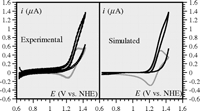Publication
657
PNAS
107, 3367–3372, 2010.
DOI: 10.1073/pnas.0914693107
|
|
|
|
|
 |
Intrinsic reactivity and driving force dependence in concerted proton-electron transfers to water illustrated by phenol oxidation |
|
|
|
|
|
Julien Bonin, Cyrille Costentin, Cyril Louault, Marc Robert, Mathilde Routier, and Jean-Michel Savéant
Laboratoire d'Electrochimie Moléculaire, Université Paris Diderot, UMR CNRS 7591, 15, rue Jean-Antoine de Baïf, 75205 Paris Cedex 13, France
Three experimental techniques, laser flash photolysis, redox catalysis, and stopped-flow, were used to investigate the variation of the oxidation rate constant of phenol in neat water with the driving force offered by a series of electron acceptors. Taking into account a result previously obtained with a low–driving force electron acceptor thus allowed scanning more than half an electron-volt driving force range. Variation of the rate constant with pH showed the transition between a direct phenol oxidation reaction at low pH, where the rate constant does not vary with pH, and a stepwise reaction involving the prior deprotonation of phenol by OH-, characterized by a unity-slope variation. Analyses of the direct oxidation kinetics, based on its variation with the driving force and on the determination of H/D isotope effects, ruled out a stepwise mechanism in which electron transfer is followed by the deprotonation of the initial cation radical at the benefit of a pathway in which proton and electron are transferred concertedly. Derivation of the characteristics of counterdiffusion in termolecular reactions allowed showing that the concerted process is under activation control. It is characterized by a remarkably small reorganization energy, in line with the electrochemical counterpart of the reaction, underpinning the very peculiar behavior of water as proton acceptor when it is used as the solvent. |

